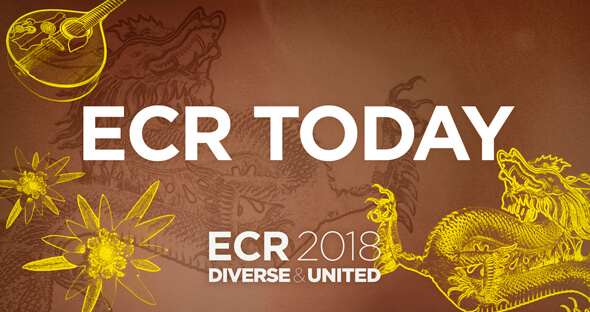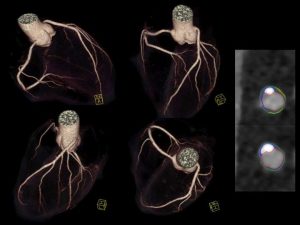The past, the present and the future – a foray through Portuguese radiology
by Katharina Miedzinska
Saturday’s ‘ESR meets Portugal’ session is a successful combination of science, culture and entertainment, offering the opportunity to discover how Portugal has contributed to the practice of radiology over the years and foresee the future of Portuguese radiology.
In an interview with ECR Today, Dr. Filipe Caseiro Alves, professor at the University Clinic of Radiology, Coimbra University Hospitals, Portugal, outlined some central themes and highlights of Saturday’s highly anticipated session.
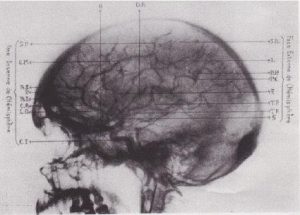
One of the first reports and image of cerebral angiography. From, Moniz E, de Carvalho L, Lima A. La radioartériographie et la topo-graphie cranioencephalique. J Radiol Electrol Med Nucl 1928;12:72. (Provided by Prof. Filipe Caseiro Alves)
At the beginning, Caseiro Alves plans to go on a short time travel through the history of Portuguese radiology. “Portugal’s greatest contributions to radiology are closely interwoven with the Portuguese School of Angiography, which began with the work of Egas Moniz, who was the first to perform a cerebral arteriography in 1927,” he explained.
Since then, Portugal has yielded many outstanding pioneers in the field of vascular radiology, among them Reynaldo dos Santos, a professor of surgery in Lisbon, who, among others, is known for the invention of aortography in 1929. Others include Lopo de Carvalho, who successfully introduced pulmonary angiography in 1931, Álvaro Rodrigues, Sousa Pereira and Roberto de Carvalho, who are known for their innovative work on lymphography (1933), Reynaldo’s son, João Cid dos Santos, who successfully introduced direct phlebography of the limbs in 1938, and Ayres de Sousa, whose name will always be closely associated with microangiography. “All these pioneer works were at the forefront of one of the most important achievements in healthcare and proved instrumental in shaping today’s medical practice,” Caseiro Alves said.
Another key topic of Caseiro Alves’s talk will be the Portuguese Society of Radiology and Nuclear Medicine (SPRMN). Founded in 1931, the SPRMN has been the mainstay of post-graduate education, regularly organising seminars, courses, and conferences that culminated with the 6th ECR in Lisbon in 1987 under the presidency of Prof. Dr. Maria Emilia Silvestre, an important figure in Portuguese radiology, who served the SPRMN for many years, and was president and member of the board from 1983 to 1991.
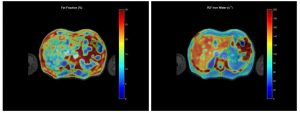
The figure (A and B) shows an example of a patient with steatosis and hepatic iron overload. These maps are advantageous to illustrate the heterogeneity of deposits throughout the liver parenchyma.
(Provided by Dr. Maria Manuela França)
“This was the last ECR held outside of Vienna and it is still remembered as being a great success,” Caseiro Alves, who is currently president of the SPRMN, noted. Nowadays, the society is the leading radiological organisation in Portugal with more than 1,000 members. “It is responsible for organising the National Congress of Radiology and extremely active in delivering continuing and post-graduate medical education around the country,” he said.
In the second part of the session, three lectures delivered by representatives of the younger generation of radiologists will function as a window into how today’s radiology practice is performed in Portugal and foresee the future of Portuguese radiology. Starting off will be Dr. Maria Manuela França, from the department of radiology at Centro Hospitalar do Porto, Portugal, who is keen to discuss the role and clinical relevance of MR imaging biomarkers for the evaluation of diffuse liver diseases.
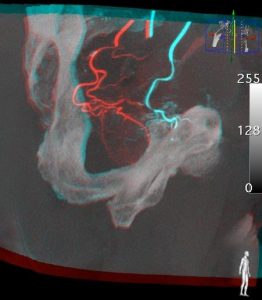
Cone-beam CT 3D reformat with overlay after bilateral selective prostate artery angiography.
(Provided by Dr. Tiago Bilhim)
Fat, iron deposits and fibrosis are common pathological features of different diffuse liver diseases. As useful as it is, liver biopsy has several limitations, and concerns over its invasiveness manifesting as pain, the possibility of complications, sampling errors, and intra- or interobserver variability have been raised. In the last decade, however, numerous attempts have been made to evaluate diffuse liver diseases by using non-invasive procedures, including new MR sequences, which have been developed to provide imaging biomarkers for various applications in patients with diffuse liver disease.
“These new MR imaging sequences are increasingly being used to evaluate hepatic fat and iron deposits and to stage liver fibrosis in different clinical scenarios of diffuse liver diseases, aiming to play a role as virtual liver biopsy,” said França. She plans to specifically outline multi-echo chemical shift-based MR sequences, which can be acquired in one or two breath-hold acquisitions, enabling the simultaneous quantification of proton density fat fraction and relaxometry rate (R2*) as imaging biomarkers for hepatic fat and iron, with high accuracy.
Regarding hepatic fibrosis, MR elastography is the best imaging technique to stage fibrosis in different diffuse liver diseases. It is less operator-dependent than ultrasound-based techniques and can readily be included in standard abdominal MRI protocols. “With growing clinical experience, all these MR imaging biomarkers are emerging as a non-invasive alternative to biopsy, increasingly being used for the non-invasive assessment of hepatic steatosis, siderosis, and fibrosis for evaluating and monitoring diffuse liver diseases,” she concluded.
Also in this session, Dr. Tiago Bilhim, from the department of interventional radiology at the Saint Louis Hospital in Lisbon, plans to address prostate artery embolisation (PAE) for benign prostate obstruction (BPO). Dr. Hugo Marques, from the department of radiology at the Hospital da Luz, Lisbon, will discuss coronary CTA and its evolution from a rule-out test to an all-in-one coronary disease assessment with prognostic validation. The session will close with a presentation on the Portuguese guitar, its sonority and its origins, and a live instrumental performance comparing the two major styles from Coimbra and Lisbon.
ESR meets Session
Saturday, March 3, 10:30–12:00, Room B
ESR meets Portugal
EM 2 Discovering Portuguese radiology: past, present, future
Presiding:
F. Caseiro Alves; Coimbra/PT
Hamm; Berlin/DE
» Introduction: SPRMN President address
Caseiro Alves; Coimbra/PT
» Imaging biomarkers for diffuse liver disease
M.M. França; Porto/PT
» Prostate artery embolisation (PAE) for benign prostate obstruction (BPO): the paradigm shift
Bilhim; Lisbon/PT
» Cardiac CT from anatomy to functional information: comprehensive CAD evaluation
Marques; Lisbon/PT
» The soul of Portugal: Facts and sounds of the Portuguese guitar
Caseiro Alves; Coimbra/PT
Costa; Coimbra/PT
Silva; Coimbra/PT
Botelho; Coimbra/PT
